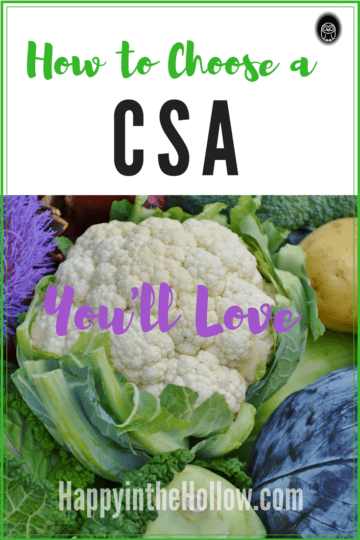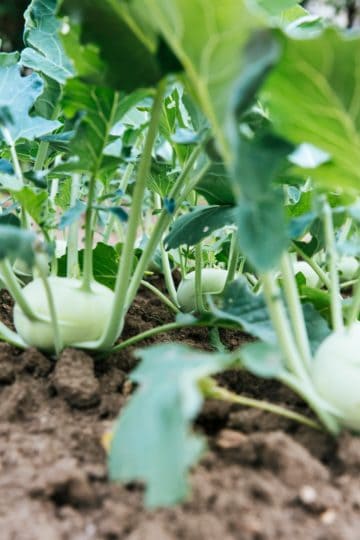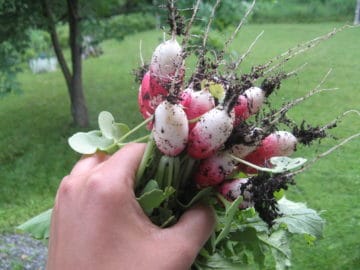Community supported agriculture (CSA) shares are an affordable way to eat fresh, in-season produce and feel good about supporting a local farm.
Use this guide to find CSA options near you. Then comes the fun part! Talk to the farmers to make your pick. Don’t be afraid to ask lots of questions. After all, you’re investing a fair amount of money in the next few months of cooking and eating.
There are quite a few things to keep in mind, so I’ve assembled a list of the most important considerations.
Consider this as you pick your CSA:
Length of season
Here in the northeast, you can look forward to 20+ weeks with your summer CSA, from around May or June through October or November. Some farms use hoop houses or root cellars to extend their season, which is how they can offer winter CSAs (great if you really – really – like greens and root vegetables). In college towns like Ithaca, you may also be able to find semester-long options. Lucky you if you live in warmer regions with year-round growing seasons!
Share size
How large a share you want to purchase will depend on your number of eaters and how much of a vegivore you are. A basic share usually feeds a small to medium household (such as two adults and a couple of kids). If your favorite farm doesn’t offer half or individual shares, you can make your own by splitting a large box with a friend or neighbor. (Just know there won’t always be two or even numbers of every item, so taking turns is an alternative.)
Price
Features can vary quite a bit between CSAs, so you may find it difficult to compare costs directly. Start by dividing the total price for the season by the number of weeks to get the price per box. Then make sure you’re comparing similarly sized shares (such as ½ or ¾ bushels).
Payment options
Payment may be required in full before the season begins or in installments, usually by credit card or Paypal online or by check. Many farms are proud to participate in programs for low-income or single-parent households and may also accept SNAP benefits. And if you’d like to get even more intimate with your food, ask about trading labor on the farm for part or all of your payment. (In fact, some CSA models require members to share in the labor.)
Pick-up options
Depending on the size of your CSA operation, you may have anywhere from one to dozens of pick-up locations (market, home, office) and times to choose from. If you get enough people together, your home or office could become a drop-off site.
Make sure to ask what happens if you can’t make your regular pick-up day. Can you go to a different place on another day or double up the following week? Can a friend get the box instead? Will any share not picked up get donated?
Box vs free choice
Some shares come in pre-packed boxes, while other CSAs offer free choice at the farm or market. There are advantages to both. Once in a while it’s nice not to have to make any decisions, but in a pre-packed box you may end up with produce you’re less inclined to use. Then again, maybe you’ll discover a new vegetable you wouldn’t have tried otherwise. Or you’re forced to come up with new, creative ways to use that weekly flood of kale.
Variety
Opening a CSA box can feel a little bit like Christmas, but it’s good to go into the season with a general sense of the products you can expect and that they match your hunger for novelty. Do you like to venture out to try new flavors and varieties (red ursa kale, harukei turnips, or black radishes, anyone?) or do you prefer to stay in more familiar culinary territory? Ask for a list of crops and check that your favorites are included.
Add-ons
You can save some shopping time if your CSA sells add-ons such as eggs, milk, cheese, bread, pickles, meat, or fruit (from the same producers or partner farms). Or maybe your pick-up is right at the market and you can shop there. If you like to can, look for a farm that lets you pre-order larger quantities of produce along with your share. I also love that our CSA includes U-pick produce: We can harvest tomatoes, herbs, flowers, and berries right at the farm.
Farming practices
Sorting out different labels (organic, naturally certified, biodynamic…) can get confusing at first, but this is a great opportunity to really engage with your prospective farm partners. Generally, they’re happy to explain their growing practices, and you can learn a lot about the decisions farmers have to make.
Some questions to ask: How big is your farm and where is your land? Do you carry any certifications? Why or why not? (Not being certified organic is not a knock-out criterion for me – actual practices are more important to me than a potentially costly certification process.) Do you spray any pesticides or use fertilizers? If yes, which ones and when? Do you grow only non-GMO crops? Who works for you and what are your labor practices? Do you buy produce from other farms?
You may also want to consider how long the farm has been in business and offering a CSA. It could take a couple of seasons for a newcomer to find its footing and sort out any organizational issues. (I’ve been a first-round member with several CSAs and have only experienced minor issues. It felt good to help farmers I believe in get started.)
Relationship
How cozy would you like to get in your new relationship? CSAs are a chance to engage with a farm in the long run, but opportunities to do so vary: Would you like to chat with your famer every week at the market, or do you prefer the convenience of receiving your box at your office building? A well-developed website, recipe databases, or weekly emails with news from the farm and a list of upcoming crops are another great way to learn more. You may even receive an invitation to visit the farm or come celebrate at a potluck or party.
I hope you find this overview helpful in choosing a CSA. Let me know in the comments which CSA you ended up picking and why.
Have a great vegetable season!
This is the final post in my community supported agriculture (CSA) series, in which I help you decide whether a CSA is a good fit, find a CSA near you, and pick the right one for your needs.
I’ll be writing more in the future on how to get the most out of your CSA, how to buy meat in bulk, and related topics.
Sign up here so you don’t miss a thing!
Kohlrabi photo by Markus Spiske/CC0




 How to Find Community Supported Agriculture (CSA) near You
How to Find Community Supported Agriculture (CSA) near You
Great tips, Olivia! My CSA experience has run the gamut from helping to organize pickup sites and building relationships with local farmers in Boston and Philadelphia to adjusting to the wonderful world of year-round produce availability as a recent transplant in Los Angeles. (Such a hardship, I know 😉 )
One of my favorite aspects of CSA is being able to purchase seconds and surplus that are fine to eat (usually impeccable, in fact) but that don’t fit the strict standards of commodity or grocery sale, and that would otherwise go to waste. It’s great to know where my food comes from, and to be able to support local farms. I hope more people will give it a shot!
Thanks, Allison! Lucky you to have year-round produce. And possibly even other types of CSAs (I’m thinking avocados, citrus)? I can’t wait for the season to start here in a few weeks.
I’ve had good and bad experiences with CSAs. These are great considerations. Now I want to set up my own CSA. You gave me some ideas!
Nice! What would you include in your CSA?
First time I heard of this. Interesting
It can be a really good option. Check out my other CSA posts to see whether it’s a good fit for you. 🙂